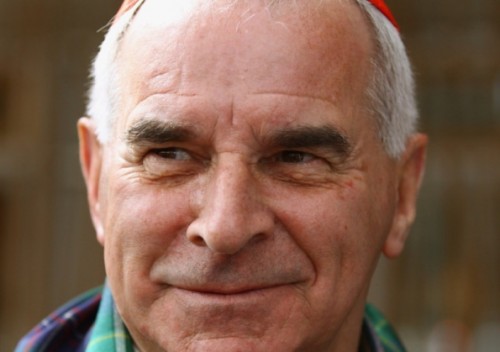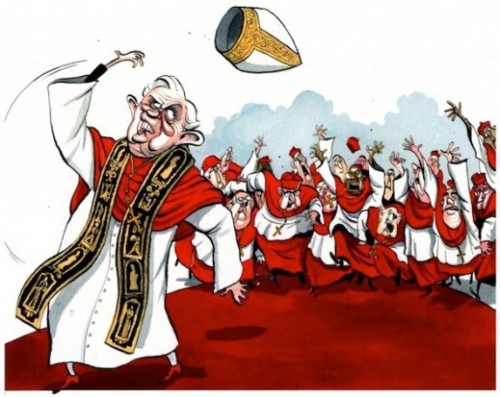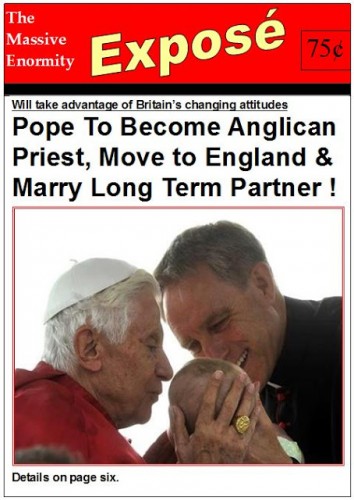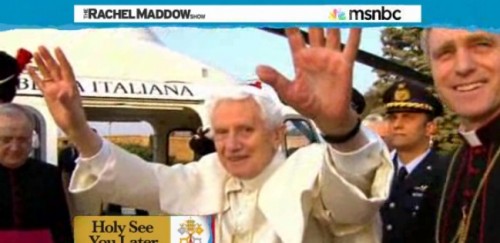What a wonderful read.
Vatican ‘knew of Cardinal O’Brien claims’
THE Vatican knew of allegations against Cardinal Keith O’Brien five months ago, it was claimed today.
Reports said a priest lodged a complaint in October about “inappropriate behaviour” by the former Archbishop of St Andrews and Edinburgh in 2001.
 The priest is said to have written directly to Rome because he did not think he could trust the church hierarchy in Scotland to handle the matter.
The priest is said to have written directly to Rome because he did not think he could trust the church hierarchy in Scotland to handle the matter.
His claim is said to have been taken seriously and led to the Vatican contacting Cardinal O’Brien and a “deal” being brokered by Cardinal Marc Ouellet of Montreal for the departure of the leader of Scotland’s Catholics.
Cardinal O’Brien quit as archbishop on Monday following revelations at the weekend about allegations from three other priests and one former priest of inappropriate behaviour dating back to the 1980s. The cardinal contests the allegations.
He had already submitted his resignation, which was due to happen on his 75th birthday on March 17, but Pope Benedict XVI ruled it should take effect immediately.
It was claimed today that it was as news of the complaint to the Vatican about the alleged 2001 incident spread inside the church that the four men decided to come forward with their stories.
One source was quoted saying: “Lots of people are pillorying the four priests whose cases came out at the weekend, but this is the context.
“It gave them the confidence that they would be heard. It started people talking and it gave them the confidence. It took someone to put his head above the parapet.”
Despite his resignation as Archbishop of St Andrews and Edinburgh, a post he had held since 1985, Cardinal O’Brien could still have gone to the conclave in Rome to help choose Benedict XVI’s successor, but he announced he would not do so, saying he did not want to distract attention from the task of electing a new pope.
The archbishop temporarily replacing Cardinal O’Brien spoke yesterday of the “pain and dismay” he shares with worshippers as he took Mass at St Mary’s Cathedral for the first time.
Archbishop of Glasgow Philip Tartaglia told worshippers that he understood the archdiocese was in a “state of shock for the loss of its shepherd” following the cardinal’s resignation.
The Pope appointed Archbishop Tartaglia as apostolic administrator to govern the archdiocese of St Andrews and Edinburgh until a permanent replacement is chosen. Archbishop Tartaglia told the congregation yesterday: “I am glad to be with you today, even if I wished, very much wished, that the circumstances were other than they are.”
He asked them to pray for the appointment of a new archbishop and said he did not know how long it would be before one is named.
He added: “The office entrusted to me by the Holy Father is by its nature provisional and temporary.”
Complete Article HERE!
He’ll be back…
Visit NBCNews.com for breaking news, world news, and news about the economy
Church needs saving from its dysfunctional structure
By DIARMAID MACCULLOCH
The Catholic Church, aka the western church of the Latin rite, trades on tradition. That is what so fascinates many people: the lure of its continuity, the certainty, the serene provision of answers.
 As anyone mildly acquainted with its history will know, this is a series of illusions. Christian history, like all history, is a delicious Smorgasbord of unintended consequences, paradoxes, misunderstandings, sudden veerings in new directions.
As anyone mildly acquainted with its history will know, this is a series of illusions. Christian history, like all history, is a delicious Smorgasbord of unintended consequences, paradoxes, misunderstandings, sudden veerings in new directions.
If you like to call that the work of the Holy Spirit, then fine, but do note that the Holy Spirit delights in confounding human expectations and going its own way.
The church of Rome, having been around from near the start of the story, illustrates this general truth particularly well. Its prestige derives from possessing the tomb of the Apostle Peter, who probably never visited the city.
This Palestinian fisherman, who would have spoken a version of Aramaic, plus enough street-Greek to make himself understood in the forum, may have been illiterate in either language, but he is represented among the books of the Bible by two elegantly-penned Greek letters written by two different authors – he himself was neither of them.
The current position of the Roman Catholic Church as the largest section of world Christianity depends on a variety of later accidents. One of these – the French Revolution of 1789 – produced the modern papacy. Until then, the pope was one Italian prince among several others.
Certainly he was equipped with a dozen centuries and more of ideological baggage, bulging with his aspirations to be something universal.
But he shared his power in the church inescapably with European Catholic monarchs, prince-bishops of the Holy Roman Empire and a host of other fiercely independent local jurisdictions in cathedrals and the like, all of which were themselves the products of the happenstance of history.
The revolution dealt them a devastating blow. As its consequences unfolded, it swept nearly all away, and the first World War delivered the coup de grace.
To begin with, it looked as if the revolutionaries would do for the pope as well. Poor Pius VI died in a revolutionary prison in France, his death in 1799 being recorded by the local mayor (with chilling Jacobin wit) as that of “Jean Ange Braschi, exercising the profession of pontiff”. But the papacy drew on its historical resources and on revulsion in much of Europe against revolutionary brutality and destructiveness.
It very successfully played the tradition card to create something brand new: a monarchy for the whole western church, which increasingly eliminated competition from rival jurisdictions. The 19th century revival of Catholicism laid the foundations of the rock-star papacy of John Paul II, kissing airport tarmac and thrilling crowds with the force of his exceptional personality.
While popular participation in secular politics has grown throughout Europe and America over two centuries, precisely the reverse has happened in the church of Rome: it has eliminated any wider participation, even that of kings.
The post-revolutionary Vatican remodelled the church across the world, to eliminate independence in church government, local initiative or scholarship.
In Ireland, the process took up the later 19th century, to produce the variety of Catholic Church still easily within the memories of many, embodied by such prelates as the late and widely unlamented John Charles McQuaid.
The reforming work of the second Vatican Council (1962-1965) looked for a moment as if it would roll back this 19th-century innovation, but the curia’s bureaucrats in the Vatican were left to implement council initiatives, and we all know the results of that in the two pontificates of John Paul II and Benedict XVI.
Benedict, arch-traditionalist, expounding even this week a narrative of Vatican II in which nothing much happened at all to the church, has by his resignation set the church on yet another new path.
It is paradoxical but admirable that this sensitive and learned man has recognised the limits of his office. The all-powerful, all-providing papacy constructed after 1789 has simply been too much for any one man to embody, regardless of whether he is frail or old.
The cardinals whom John Paul and Benedict appointed to parrot the myth of enduring tradition will no doubt resist the implications, scrabbling around to find the most convincing representative of the post-French Revolution state of the hierarchy. But it is just possible that the Holy Spirit might seize them afresh.
Wouldn’t it be a wonderful surprise for the Christian world if they reached beyond the conclave and chose someone from beyond their ranks? That’s a big ask at the moment. But look back before the French Revolution, and we can find stories to help the church in framing a more workable version of its future than the present dysfunctional structure.
At the moment, the debate between Catholic “liberals” and “conservatives” is stuck around the second Vatican Council: what happened there? Not much? A lot? Even more than a lot, but frustrated by the Curia? Let’s recognise that the debate is much older than that.
A great many Catholics over the centuries have considered a monarchical papacy a very bad idea: particularly all those monarchs, prince-bishops, cathedral chapters. They constructed coherent theologies out of their convictions.
Historians use labels for these ways of thinking which have become merely pieces of historical jargon: Gallicanism; Cisalpinism; Conciliarism.
It’s a pity that these words now seem off-putting and archaic, because once they were living affirmations that the church’s future should be decided in broader arenas than a few chambers in the Vatican palace.
That future won’t resemble the past – it never does – so I’m not suggesting we restore the Holy Roman Empire, or the heirs of Louis XVI to the French throne. But history has rich resources to offer: showing how they did things in the past, so Catholics can find sensible solutions for what to do next.
In the middle of what any fool can see is a deep crisis in Catholic Church authority, let historians ride to the rescue.
Complete Article HERE!
The new pope’s three key challenges
An obstructionist Vatican, a chronic shortage of priests and a shrinking worldwide congregation: the list is daunting
By Andrew Brown
When 117 cardinals gather in Rome to choose the next pope this month, the first thing that will determine their choice is what job they are hiring the man for. Catholicism is in a crisis: the historian Diarmaid MacCulloch compares it to the great changes of the Reformation and the medieval reforms, 400 years earlier, under Pope Innocent VII.
 The convulsions that started with the second Vatican council of the 1960s have still not played themselves out. On the other hand, the pope will still be a Catholic. There are not going to be female priests, and only what absolutely has to change will change. The ban on contraception will remain: the best – and the least – that can happen is that it is quietly ignored, even by the hierarchy, and no longer used as the shibboleth of orthodoxy in any priest who wants promotion. Some things can’t change, and we shouldn’t assume that the new leader will take up the agenda of the Guardian or the New York Times.
The convulsions that started with the second Vatican council of the 1960s have still not played themselves out. On the other hand, the pope will still be a Catholic. There are not going to be female priests, and only what absolutely has to change will change. The ban on contraception will remain: the best – and the least – that can happen is that it is quietly ignored, even by the hierarchy, and no longer used as the shibboleth of orthodoxy in any priest who wants promotion. Some things can’t change, and we shouldn’t assume that the new leader will take up the agenda of the Guardian or the New York Times.
But it’s clear from the pope’s resignation that he knows things can’t go on as they are. So what does the crisis look like from Rome?
It seems to me that there are three interlocking difficulties for the church. There is crisis in the curia, the Vatican itself. There is a crisis in the clergy. And in the developed world, there is a crisis in the laity.
There is also a strategic problem in that the church must deal with the increasing militancy of Islam in the Middle East, and, beyond that, the rise of China and India. But that doesn’t require new thinking, just the application of well-practised principles.
The problems of the laity and clergy are intertwined, and in the developed world their symptom is obvious: there are not enough of either, and both are ageing rapidly and sustained only by immigration from the south.
There is little that a pope can do directly about the problem of the shrinking laity, even in an age of global travel. Wherever he goes, he can draw vast crowds, but the interest and excitement subside when he has gone. The congregations continue to drain away.
The effect has been most marked in places where Catholicism was part of the national or regional identity – Ireland, Quebec, Boston and France come to mind. But it has happened almost everywhere in the developed world. And in the countries where churchgoing has shrunk, the clergy have also got older and – by report – more gay. Seminaries have closed. More and more priests are imported from Africa, from Latin America, and from the Philippines or Vietnam.
That is something the new pope could do something about, but only by relaxing the mandatory celibacy rule. To allow the ordination of already married men on a much wider scale than already happens with Anglican converts would transform the priesthood and bind it much more closely to the laity. From the outside, such a development looks inevitable.
Whether it seems so simple inside the Sistine chapel is another question. But, if it does, the electors will choose accordingly. Paradoxically, they are more likely then to choose a cardinal from Latin America or Asia, where the celibacy rules are already widely ignored, than from Europe or North America, where they are followed in the letter, if not in spirit.
Changing the rules on celibacy would still be a convulsive step that would bring fresh problems of its own. But it may appear to the cardinals a necessary and unavoidable adjustment to a reality that can no longer be denied.
The problem of the curia is different in nature. The central administration of the Vatican is plagued by corruption allegations and obstructionism. It functions too much like the rest of Italy. A pope of enormous energy and willpower and administrative experience would be needed to clean it out. Yet this, too, may be inevitable, as the VatiLeaks scandal showed. The Italian model of politics doesn’t even work in Italy. You can’t run a global organisation on those principles.
Any loosening of central control would also be fraught with dangers for the church’s coherence. A liberal reformer might suffer the fate of a Gorbachev and be swept aside by the forces he unleashed. I suspect that the reform of the curia would be the priority of any non-Italian European, such as Cardinal Christoph Schönborn of Austria. But I doubt the electors have any great enthusiasm for the task.
Complete Article HERE!


